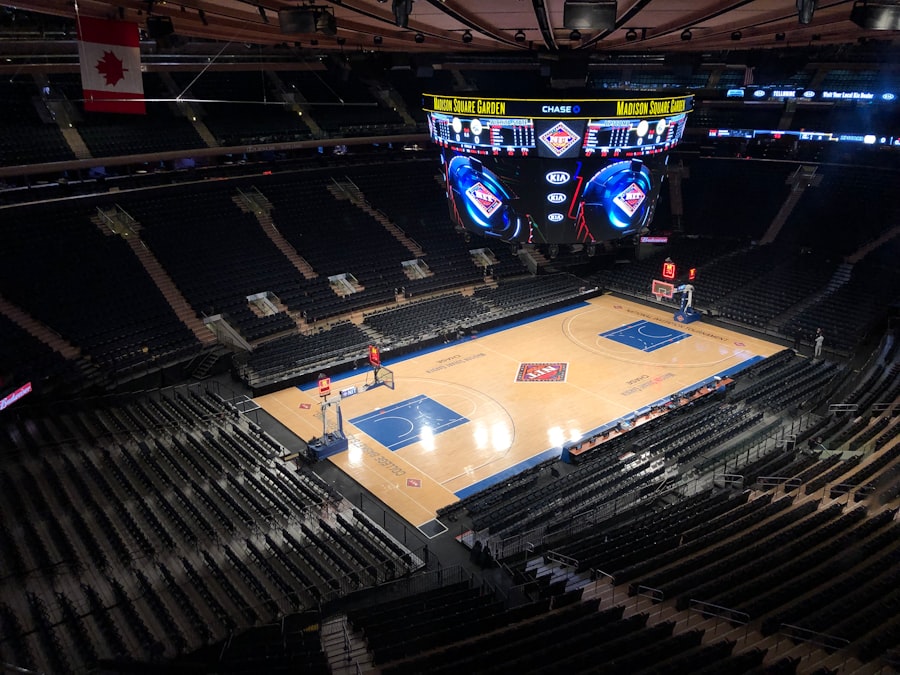Download links
How to install The Impact of NBA's Global Expansion APK?
1. Tap the downloaded The Impact of NBA's Global Expansion APK file.
2. Touch install.
3. Follow the steps on the screen.
Description
The National Basketball Association (NBA) has undergone a remarkable transformation over the past few decades, evolving from a primarily North American league into a global phenomenon. This expansion is not merely a matter of geographical reach; it encompasses a complex interplay of cultural, economic, and social factors that have propelled basketball into the hearts of millions worldwide. The NBA’s journey began in earnest during the 1980s and 1990s, with the rise of iconic players like Michael Jordan, who transcended the sport and became a global ambassador for basketball.
The league’s strategic initiatives, including international games, partnerships, and grassroots programs, have played a pivotal role in fostering a global fan base. As the NBA continues to expand its footprint, it has embraced various strategies to engage international markets. The introduction of the NBA Global Games, where teams travel abroad to play exhibition matches, has been instrumental in showcasing the league’s talent and generating excitement among local fans.
Additionally, the NBA has established partnerships with international organizations and leagues, further solidifying its presence on the global stage. This expansion is not just about increasing viewership; it is about creating a shared cultural experience that resonates with diverse audiences, ultimately transforming basketball into a universal language.
Key Takeaways
- The NBA has been actively expanding its global presence, reaching fans and markets around the world.
- The economic impact of the NBA’s global expansion has been significant, with increased revenue from international markets and partnerships.
- The NBA’s global expansion has had a profound cultural impact, influencing fashion, music, and entertainment worldwide.
- The league’s global expansion has also led to increased player development and recruitment from diverse international talent pools.
- Media and broadcasting opportunities have expanded with the NBA’s global reach, leading to increased viewership and revenue.
Economic Impact of NBA’s Global Expansion
New Revenue Streams
For instance, the NBA signed a landmark deal with Tencent in China, allowing the streaming of games and related content to millions of fans. This partnership not only generated substantial revenue but also solidified the NBA’s status as a leading sports entity in one of the world’s largest markets.
Economic Impact Beyond Revenue Generation
The NBA’s global presence has stimulated local economies through tourism and related activities. When teams travel for international games, they bring with them not only their players but also their fan bases, creating a surge in hotel bookings, restaurant patronage, and local merchandise sales. Cities that host these games often experience a significant boost in economic activity, showcasing how sports can serve as a catalyst for broader economic development.
Community Engagement and Economic Footprint
The NBA’s commitment to community engagement through initiatives like basketball clinics and youth programs further enhances its economic footprint by fostering local talent and promoting healthy lifestyles.
Cultural Impact of NBA’s Global Expansion

The cultural impact of the NBA’s global expansion is perhaps one of its most significant achievements. Basketball has become more than just a sport; it is now a cultural phenomenon that transcends borders and unites people from diverse backgrounds. The league’s ability to connect with fans on an emotional level has fostered a sense of belonging and community among its global audience.
This cultural exchange is evident in how basketball has influenced music, fashion, and lifestyle trends around the world. For example, hip-hop culture has intertwined with basketball culture, leading to collaborations between artists and players that resonate with fans across continents. Furthermore, the NBA has actively promoted inclusivity and diversity through its global initiatives.
By showcasing players from various nationalities and backgrounds, the league has highlighted the universal appeal of basketball. Events like the NBA Africa Game not only celebrate African talent but also promote social change by addressing issues such as education and health in local communities. This cultural diplomacy fosters goodwill and understanding among nations, demonstrating how sports can serve as a bridge between cultures.
Player Development and Recruitment
| Category | Metrics |
|---|---|
| Player Development | Player improvement rate |
| Training hours per player | |
| Performance in matches | |
| Recruitment | Number of new players recruited |
| Recruitment cost per player |
The NBA’s global expansion has significantly transformed player development and recruitment strategies. With an increasing number of international players making their mark in the league, teams are now scouting talent from regions previously overlooked. The success stories of players like Dirk Nowitzki from Germany, Yao Ming from China, and Giannis Antetokounmpo from Greece have paved the way for a more inclusive approach to talent identification.
NBA teams are investing in international scouting networks to discover emerging talent in countries where basketball is gaining popularity. Moreover, the league has established various programs aimed at nurturing young talent worldwide. Initiatives such as the Basketball Without Borders program provide aspiring players with training opportunities while promoting values like teamwork and leadership.
These programs not only enhance skill development but also create pathways for young athletes to pursue their dreams of playing in the NBAs a result, the league is witnessing an influx of skilled players from diverse backgrounds, enriching the competitive landscape and bringing fresh perspectives to the game.
Media and Broadcasting Opportunities
The media landscape surrounding sports has evolved dramatically in recent years, and the NBA has adeptly navigated this shift to maximize its global reach. The rise of digital platforms has transformed how fans consume sports content, leading to innovative broadcasting strategies that cater to diverse audiences. The NBA has embraced streaming services and social media platforms to engage fans directly, allowing them to access games and highlights anytime, anywhere.
This approach not only broadens viewership but also enhances fan interaction through real-time engagement. International broadcasting deals have also played a crucial role in expanding the NBA’s audience. Partnerships with networks around the world ensure that games are accessible to fans in various regions, further solidifying the league’s global presence.
For instance, agreements with broadcasters in Europe and Asia have made it possible for millions of fans to follow their favorite teams and players closely. The NBA’s commitment to producing localized content tailored to specific markets demonstrates its understanding of cultural nuances and preferences, ultimately fostering deeper connections with fans.
Fan Engagement and Market Growth

Enhancing the Viewing Experience
These initiatives allow fans to feel connected to their favorite teams and players beyond traditional viewing experiences. Market growth is also evident in the increasing number of NBA academies established worldwide.
Investing in Grassroots Programs
These academies serve as training centers for young athletes while promoting basketball as a means of personal development.
A Long-term Approach to Market Growth
This long-term approach not only strengthens market growth but also ensures that basketball remains relevant across different cultures.
Challenges and Criticisms of NBA’s Global Expansion
Despite its successes, the NBA’s global expansion is not without challenges and criticisms. One significant concern revolves around cultural appropriation and commercialization of basketball in different regions. Critics argue that while the league promotes inclusivity, it sometimes overlooks local traditions and values in favor of profit-driven strategies.
This can lead to a disconnect between the league’s branding efforts and the authentic experiences sought by local fans. Additionally, there are logistical challenges associated with maintaining a global presence. Time zone differences can complicate scheduling for games and broadcasts, making it difficult for fans in certain regions to engage fully with the league.
Furthermore, geopolitical tensions can impact international relations and hinder collaboration with certain markets. The NBA must navigate these complexities while remaining committed to its mission of promoting basketball as a unifying force.
Future Prospects and Opportunities for NBA’s Global Expansion
Looking ahead, the future prospects for the NBA’s global expansion appear promising yet require strategic foresight. As basketball continues to gain popularity worldwide, particularly in regions like Africa and Southeast Asia, there are ample opportunities for growth. The league can capitalize on emerging markets by tailoring its approach to meet local preferences while fostering grassroots initiatives that promote participation at all levels.
Moreover, advancements in technology present new avenues for engagement. The integration of augmented reality (AR) and virtual reality (VR) into fan experiences could revolutionize how fans interact with the game. Imagine attending a virtual game where fans can experience live action from different angles or participate in interactive challenges alongside their favorite players.
Such innovations could further deepen fan loyalty while attracting new audiences. In conclusion, as the NBA continues its journey toward becoming a truly global league, it must remain adaptable and responsive to changing dynamics within international markets. By prioritizing cultural sensitivity, investing in player development, and leveraging technological advancements, the league can ensure its relevance for generations to come while continuing to inspire millions around the world through the power of basketball.
If you’re a fan of the NBA, you may be interested in reading about the latest technology being used in fishing. Check out this article on the benefits and newest technologies in fishing at tg777.fans. It’s always fascinating to see how advancements in technology are impacting various industries, just like how innovations are changing the game in the NBA.
FAQs
What does NBA stand for?
NBA stands for National Basketball Association.
When was the NBA founded?
The NBA was founded on June 6, 1946.
How many teams are in the NBA?
There are 30 teams in the NBA.
What are the most successful NBA teams?
The Boston Celtics and the Los Angeles Lakers are the most successful NBA teams, having won the most championships in the league’s history.
Who is the all-time leading scorer in the NBA?
Kareem Abdul-Jabbar is the all-time leading scorer in the NBA, with 38,387 points scored in his career.
What is the NBA Finals?
The NBA Finals is the championship series of the NBA, where the Eastern Conference champion and the Western Conference champion compete for the league title.
Who is the current NBA MVP?
The current NBA MVP is Giannis Antetokounmpo of the Milwaukee Bucks.
How long is an NBA game?
An NBA game consists of four quarters, each lasting 12 minutes, for a total of 48 minutes of playing time.





